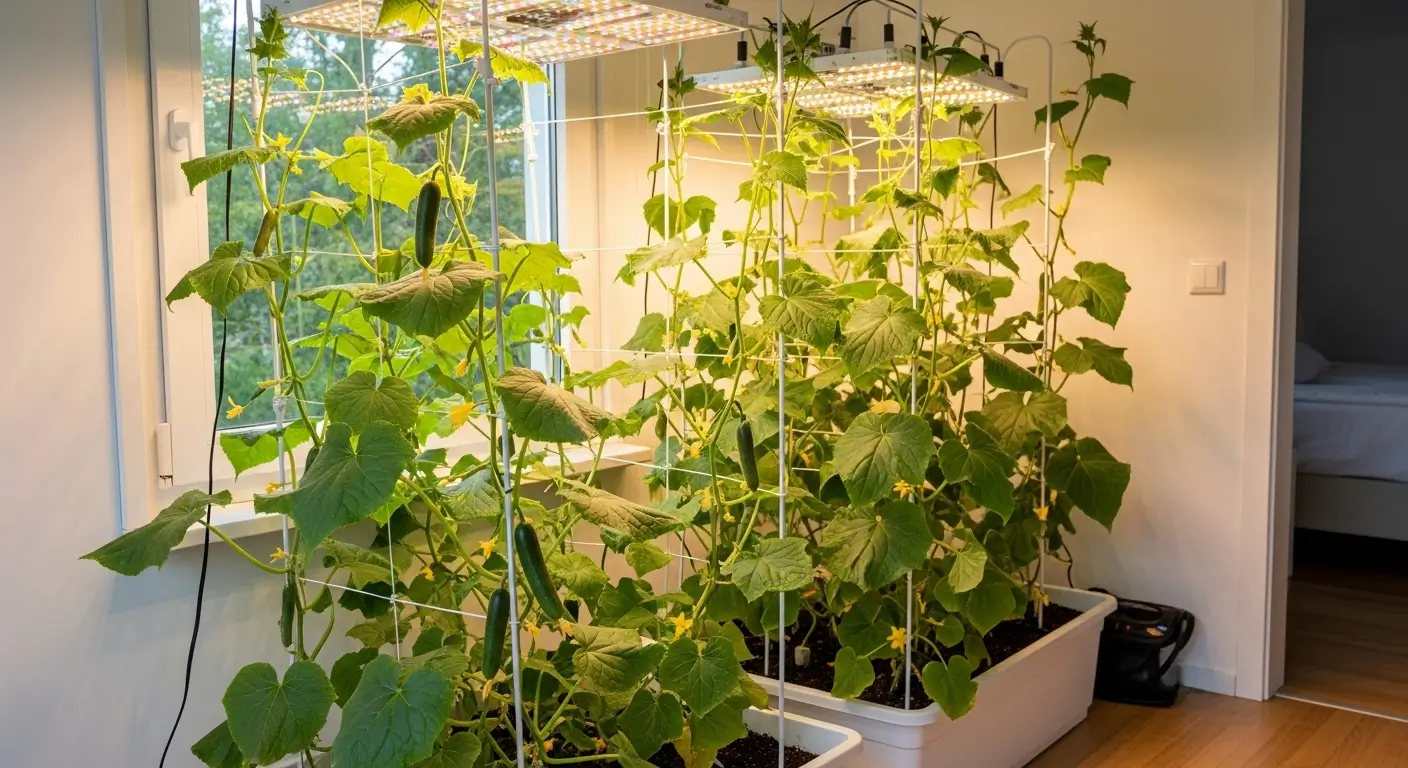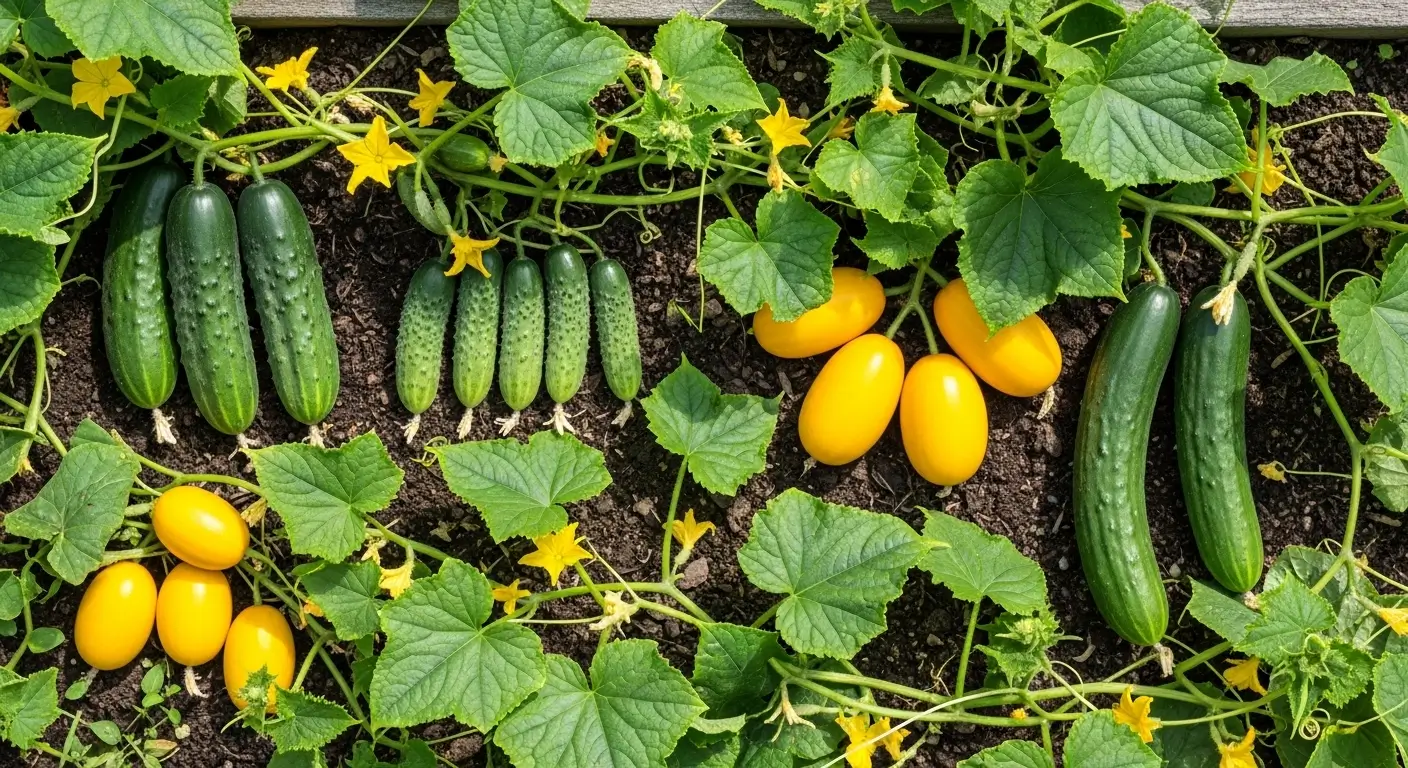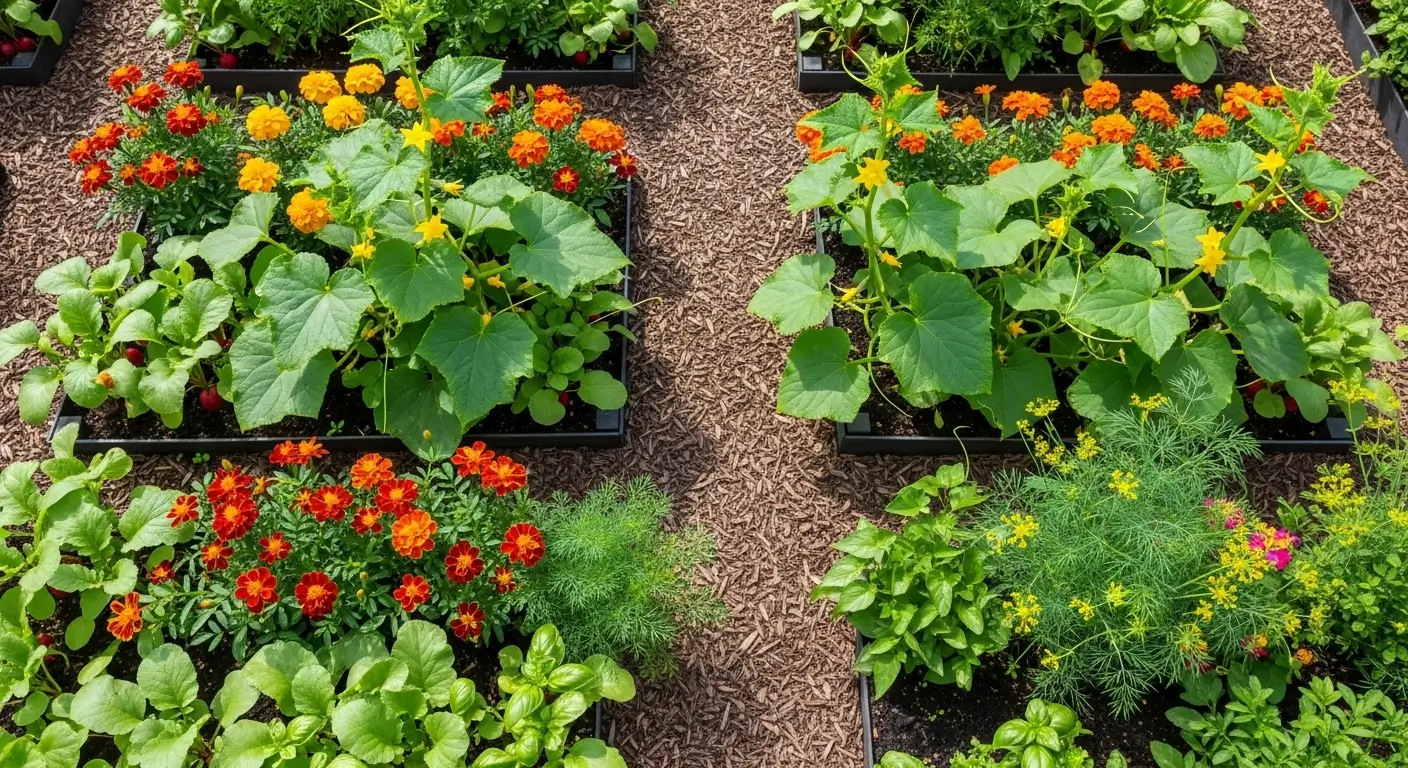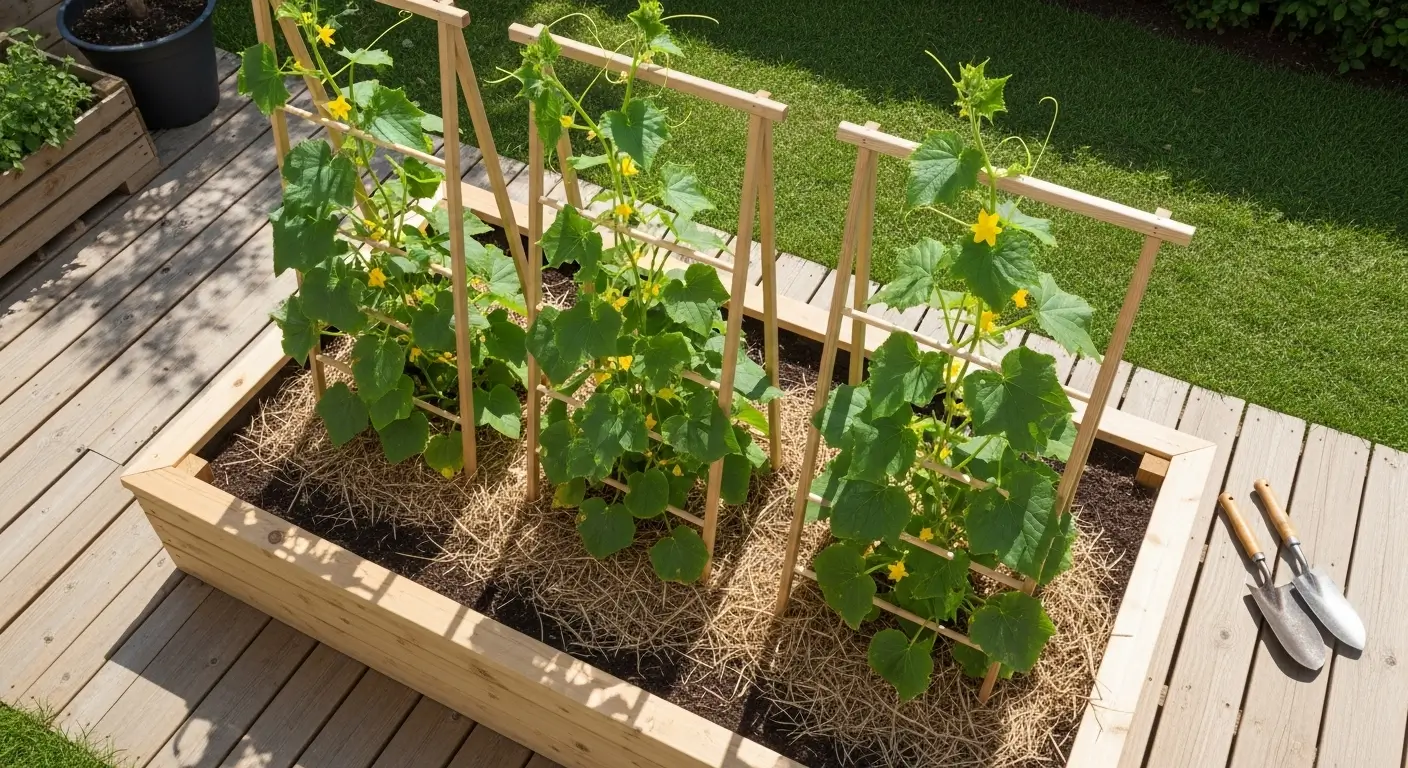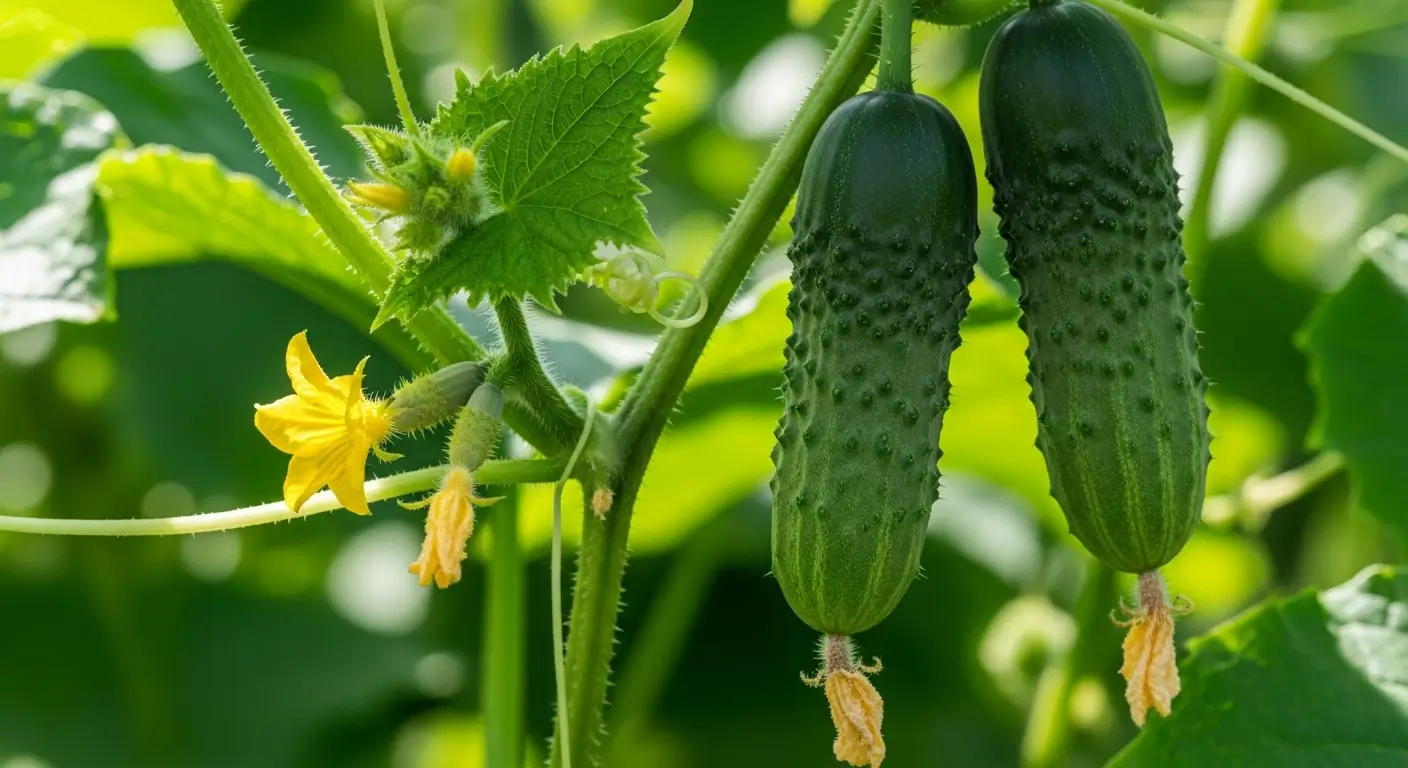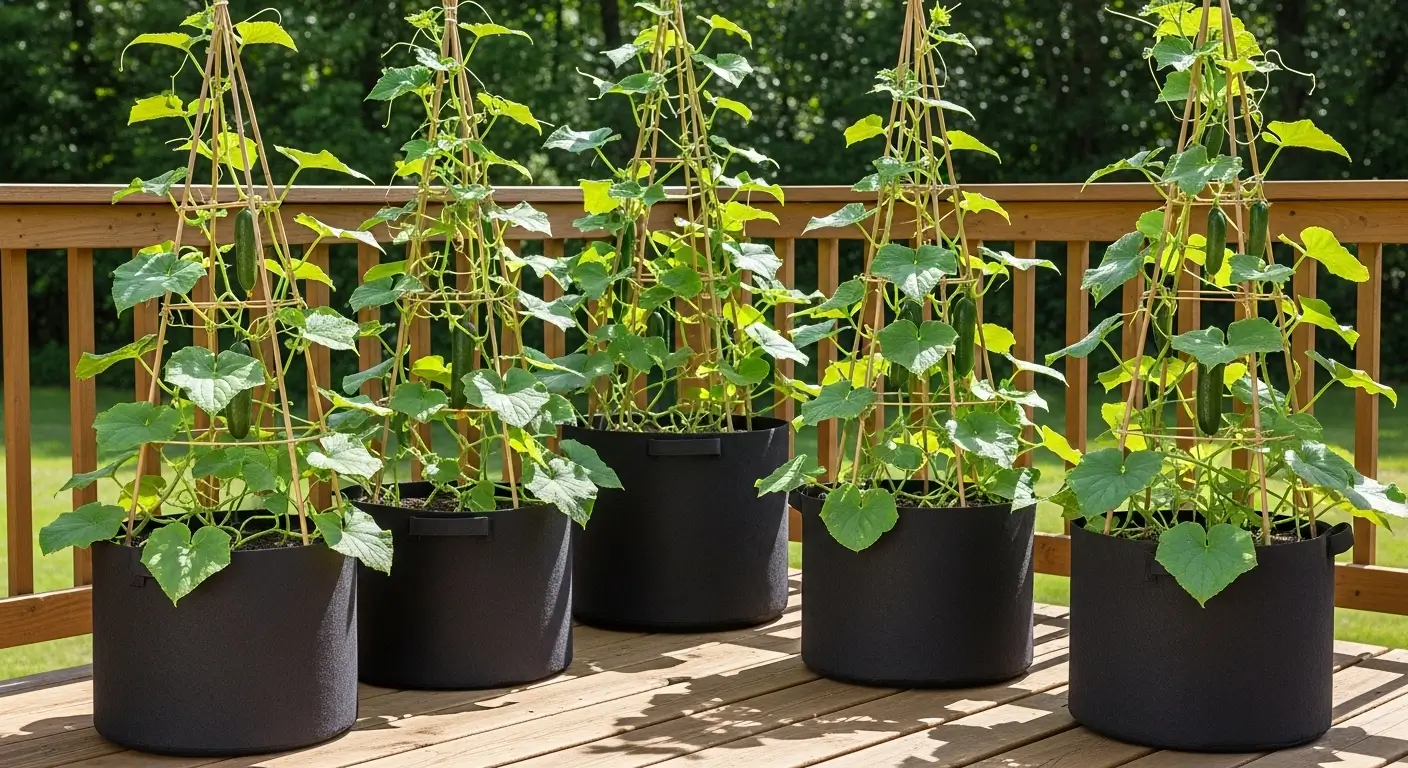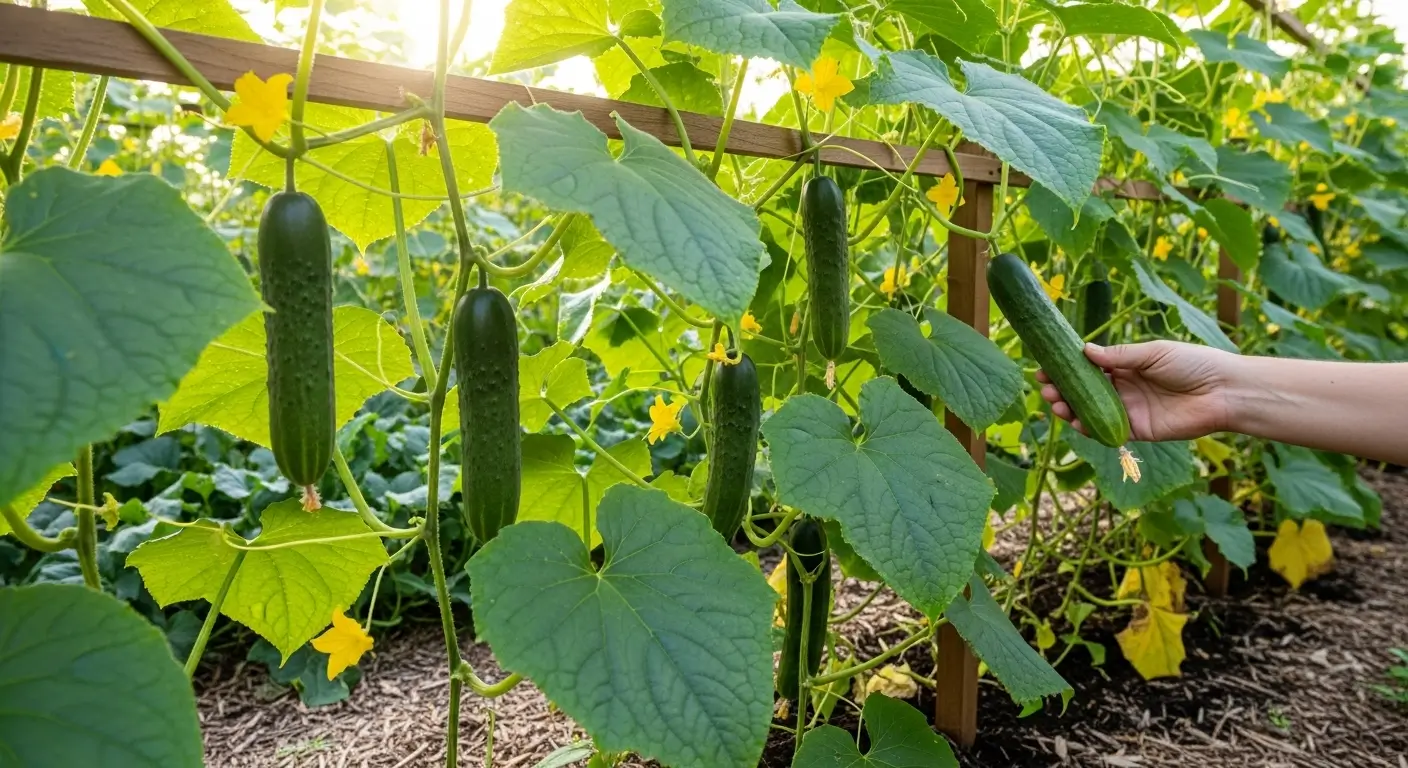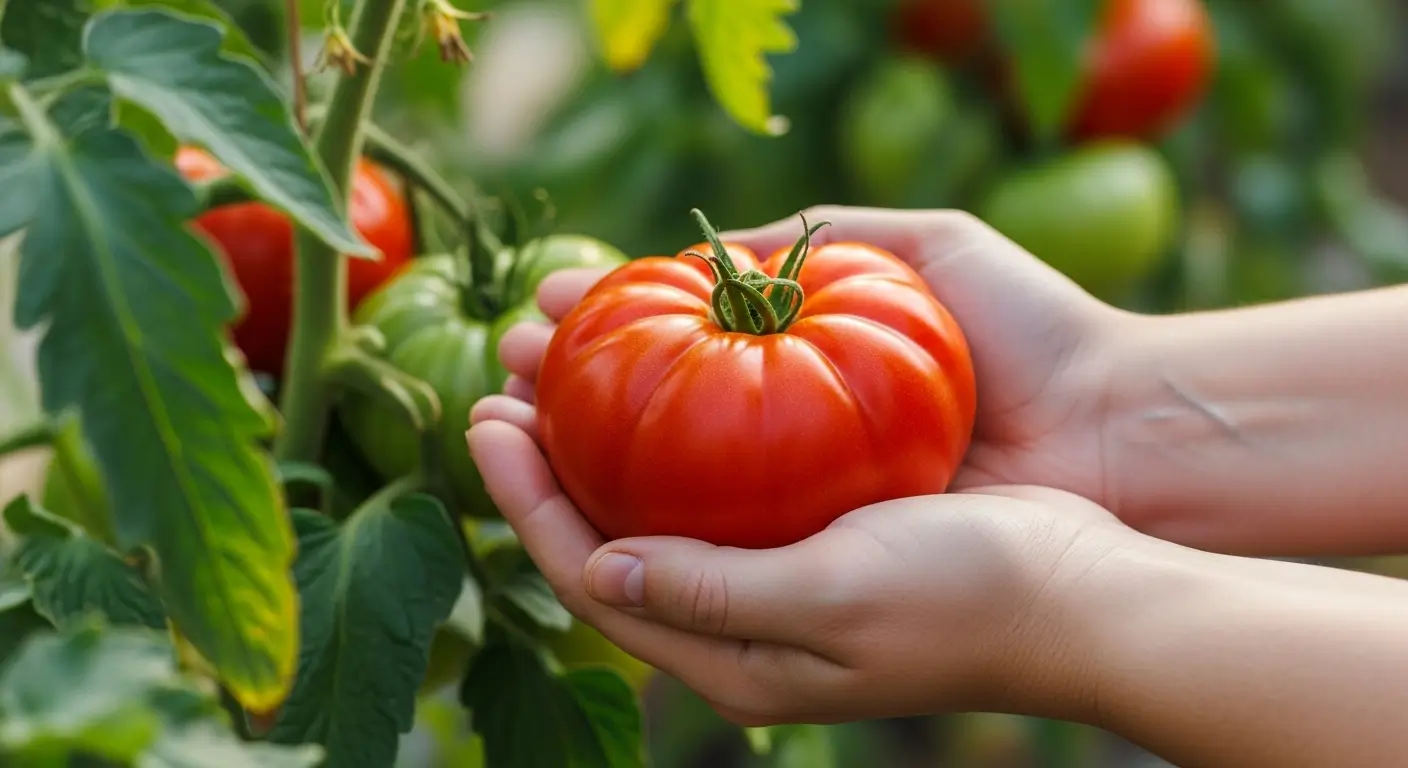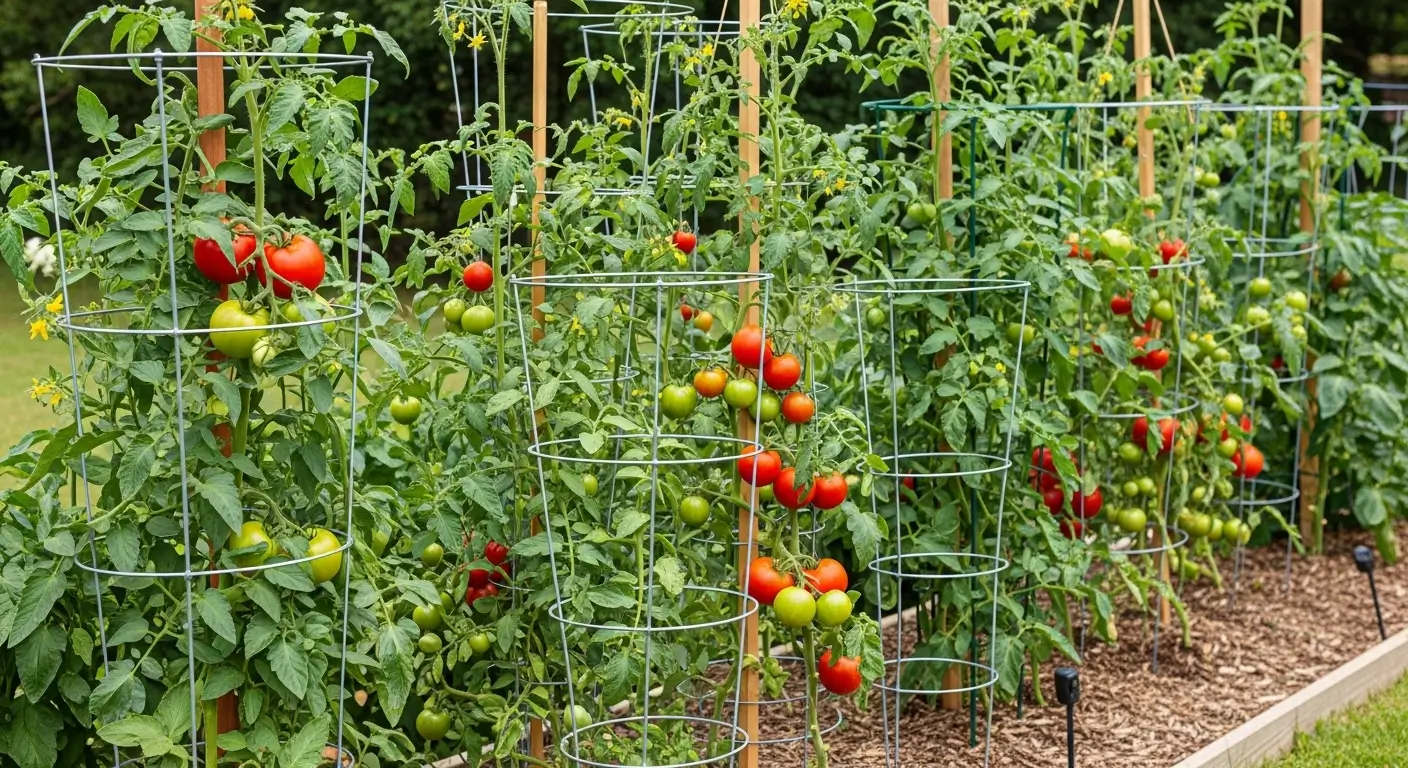Okay, picture this: it’s freezing cold outside, snow everywhere, and you just walked into your kitchen and grabbed a super fresh, crunchy cucumber from your own little indoor garden. I’m not kidding – the first time I pulled this off, I literally did a happy dance in my pajamas! My husband thought I’d lost it, but biting into that cucumber while looking at the winter wasteland outside was like having my own slice of summer.
Here’s what you need to know:
- You can totally grow cucumbers inside all year (yes, really!)
- Pick the right tiny varieties and give ’em something to climb on
- Get your temperature and lights sorted, and you’re golden
- You’ll become a bee (I’ll explain later – it’s actually fun!)
- If you can grow stuff in pots, you can nail this
Table of Contents
Why Growing Cucumbers Indoors Makes Perfect Sense
I used to think indoor cucumber growing was some fancy schmancy greenhouse thing that only serious gardeners with too much time did. Turns out I was totally wrong! After messing around with this for years (and killing more plants than I care to admit), I’ve figured out it’s one of the coolest ways to have fresh cukes whenever you want.
The best part? You’re basically the boss of everything. Don’t worry about those evil cucumber beetles that seem to have GPS tracking on your outdoor plants. No late frosts ruining your day. No droughts are making your cucumbers taste like cardboard. You control it all!
I’ve grown these babies in spare rooms, the basement, and yes – even in a closet once. (Don’t tell my husband about the closet thing… he still doesn’t know why that room smelled so earthy that winter!) The secret is that cucumbers are way more chill than people think. They need their basic needs met, kind of like teenagers.
Setting Up Your Indoor Cucumber Growing Paradise
Choosing the Perfect Location
Your setup starts with finding the right spot, and trust me, I learned this the hard way after moving my whole operation three times in one year. Cucumbers are basically space hogs – they need room to spread out and climb up. My current setup takes over a corner of our guest room, and I need about 6-8 feet of ceiling height.
Here’s the thing about temperature – these plants are picky! They want it between 70-75°F during the day and never below 60°F at night. I’m obsessive about checking this with my digital thermometer because I’ve learned that even being off by a few degrees makes them sulk and grow super slowly.
And don’t forget about air flow! I run a little fan because stagnant air is an invitation for gross fungal stuff. Trust me, dealing with powdery mildew indoors is about as fun as cleaning the bathroom – which is not fun at all.
Lighting: The Make-or-Break Factor
Okay, here’s where most people mess up big time – they totally underestimate how much light these things need. I mean, cucumbers are basically sun worshippers that want 12-16 hours of bright light every single day. That pretty window you’re eyeing? Probably not gonna cut it, especially in winter.
I bit the bullet and got some decent LED grow lights about 12-18 inches above my plants. Yeah, I tried the cheap fluorescent ones first (because who doesn’t love saving money?), but wow, the difference with good LEDs is like night and day. Your wallet might cry a little upfront, but your plants will be so much happier.
My lights run from 6 AM to 10 PM – that’s 16 hours of fake sunshine. I use a timer because let’s be real, I’m way too scatterbrained to remember to turn them on and off manually every single day!
Selecting the Right Cucumber Varieties for Indoor Success
Not all cucumbers are meant for indoor life, and I learned this lesson the hard way! I once tried growing those massive outdoor slicing cucumbers in containers. What a hot mess that was – vines everywhere, taking over half the room like some green monster, and the cucumbers were just… meh.
Top Performers for Indoor Growing
Bush varieties are your absolute best friends here. ‘Bush Champion’ and ‘Spacemaster’ have been total rockstars in my setup. These little guys stay friendly and manageable but still pump out full-size cucumbers like champs.
Dwarf varieties like ‘Patio Pik’ and ‘Pick a Bushel’ are perfect if you’re working with limited space. Don’t let the name fool you – these tiny powerhouses can surprise you with how much they produce!
Asian varieties such as ‘Suyo Long’ and ‘Japanese Climbing’ work awesome with vertical setups. They seem way more adaptable to indoor life than the typical American varieties – maybe they’re just more easygoing?
For more info about different cucumber types and growing tricks, check out our complete cucumber growing guide – it’s packed with good stuff.
Container Selection and Soil Preparation
Choosing the Right Containers
Size really, really matters here! I use containers that are at least 20 gallons for bush types and 30 gallons for the climbing ones. I know, they’re huge and ugly, but cucumber roots are serious business. Cramped roots equal sad, disappointing harvests, and nobody wants that.
Drainage is super important, too. I drill extra holes in the bottom (more is better!) and throw in some gravel before adding soil. Standing water is basically plant death soup, so don’t skip this step.
Pro tip: get containers with wheels! I put mine on those rolling plant caddies, and it’s been a total game-changer for moving things around and cleaning up.
Creating the Perfect Growing Medium
Regular potting soil from the store just isn’t gonna cut it for cucumbers. I make my own mix with good potting soil, compost, perlite for drainage, and a handful of worm castings for that slow-release nutrition boost.
Keep the pH between 6.0 and 7.0 (slightly acidic to neutral). I test this regularly because it can drift indoors, especially with all the watering. A cheap pH meter from the garden center does the job perfectly.
Want more container tips? Check out our cucumber container growing guide for even more container tricks.
Support Systems: Letting Your Cucumbers Climb to Success
Even the bush types like having something to lean on indoors. I use bamboo stakes and soft ties to create a little framework that grows with the plants.
My favorite setup is this trellis thing I made with PVC pipes and garden netting. It’s lightweight, adjustable, and can hold heavy vines loaded with cucumbers. The trick is setting it up early – trying to add support later is like trying to put shoes on a toddler who doesn’t want to wear shoes. Not fun.
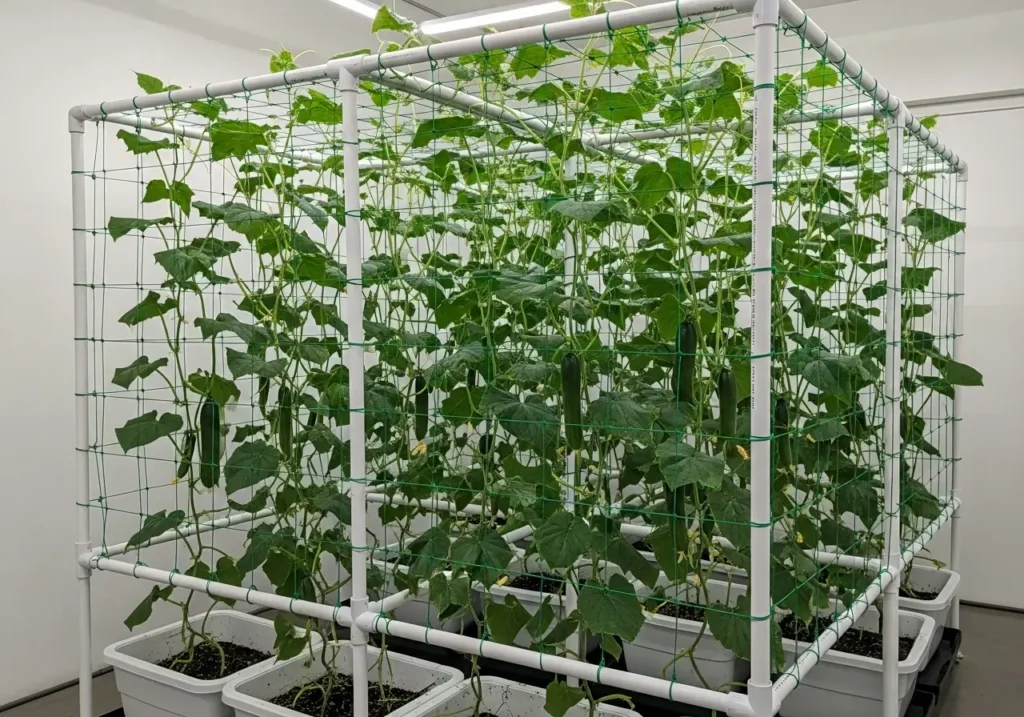
For the climbing varieties, I go full vertical and let them climb up toward the ceiling. The cucumbers hang down beautifully, grow straighter, and are way easier to pick when they’re adequately supported.
The Art of Indoor Cucumber Pollination
Here’s where things get interesting – you get to play bee! Outside, real bees handle the pollination, but inside, that’s your job now.
I use a tiny paintbrush to move pollen from the boy flowers to the girl flowers. The girl flowers are easy to spot because they have this slight baby cucumber shape at the base. The boy flowers show up first, and there are way more of them. For more detailed information about cucumber flower biology and pollination requirements, Penn State Extension’s cucumber production guide offers comprehensive insights into both monoecious and gynoecious varieties.
Early morning is the best time for this because the pollen is freshest. I gently brush inside each boy flower to collect pollen, then dab it into the center of the girl flowers. It sounds tedious, but it’s actually become this weird, relaxing morning routine for me. Plus, the payoff is totally worth it!
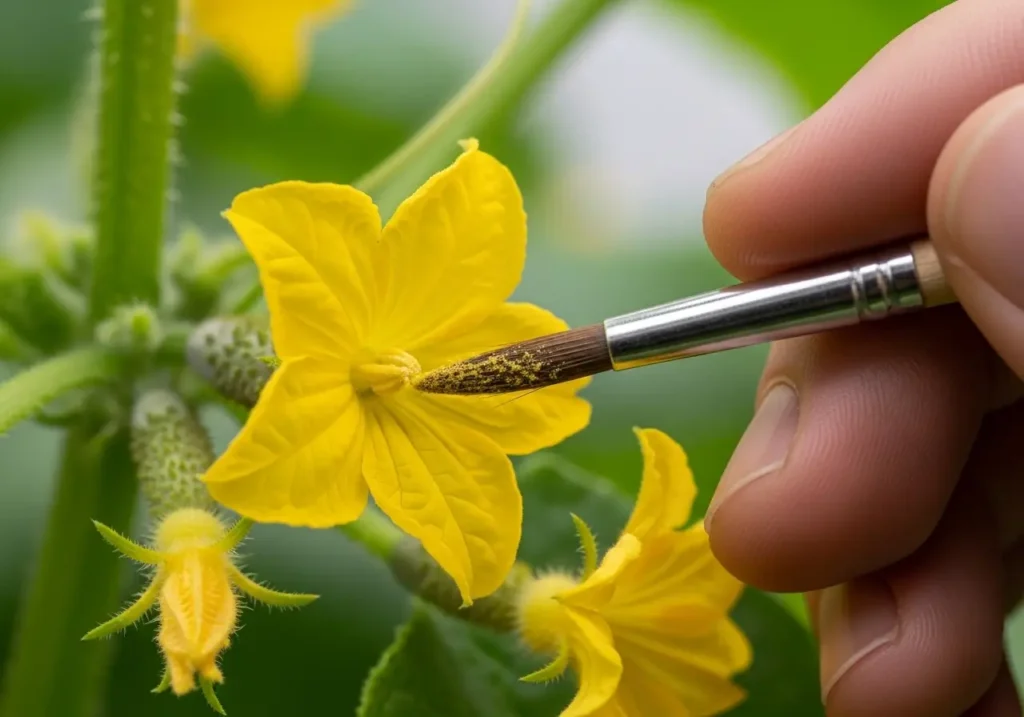
Some people skip all this and grow seedless varieties, but I like doing it the old-fashioned way. Better flavor, and I can save seeds if I want to.
Watering Wisdom for Indoor Cucumber Success
Consistent water is key, but here’s the thing – more people kill their indoor cucumbers with too much water than too little. I water when the top inch of soil feels dry, which is usually every 2-3 days depending on how warm and dry it is.
I use room temperature water and pour it slowly around the base, avoiding the leaves because wet leaves are basically an invitation for fungal problems. A moisture meter takes all the guesswork out of this – such a simple gadget, but super helpful.
Humidity should be around 50-70%. Too low, the plants get stressed, too high, and you get gross fungal stuff. I run a humidifier in winter when the indoor air gets really dry.
Feeding Your Indoor Cucumber Plants
Indoor cucumbers are basically eating machines, especially when cranking fruit non-stop. I feed them liquid fertilizer every two weeks, then switch to higher-potassium stuff once they start flowering to help with fruit production.
Organic fertilizers work great indoors. Fish emulsion and kelp meal are fantastic, though fair warning – they can smell pretty funky. I usually apply these when it’s nice enough to open windows for air circulation!
Watch for yellow leaves (usually means they need more nitrogen) or blossom end rot (calcium problems or inconsistent watering).
Common Challenges and Solutions
Managing Growth in Limited Space
Even the compact varieties can get a little crazy indoors. I pinch the growing tips when they hit the ceiling and regularly trim side shoots to keep things manageable. Don’t be shy about pruning – it actually encourages more fruit production!
Preventing Pest Problems
Spider mites love warm, dry indoor conditions. I keep them away with regular misting and good humidity levels. Yellow sticky traps catch any flying bugs before they become a real problem.
Aphids sometimes show up (usually hitchhiking on other plants). A gentle spray with soapy water gets rid of them fast. The key is catching problems early by checking your plants regularly.
Dealing with Disease Issues
Powdery mildew can be tricky indoors. Good air circulation and not watering the leaves help prevent it. If it shows up anyway, a baking soda spray (1 teaspoon per quart of water) usually takes care of mild cases.
Harvesting Your Indoor Cucumber Success
This is the best part! Indoor cucumbers can produce fruit year-round if you take good care of them. I harvest when they’re full size but still firm and bright green.
Keep picking regularly – it encourages the plants to make more. I check every day and pick them slightly smaller rather than letting them get oversized, which can slow down production.
Fresh indoor cucumbers taste incredible – crispy, sweet, and not that bitter taste you sometimes get with store-bought ones.
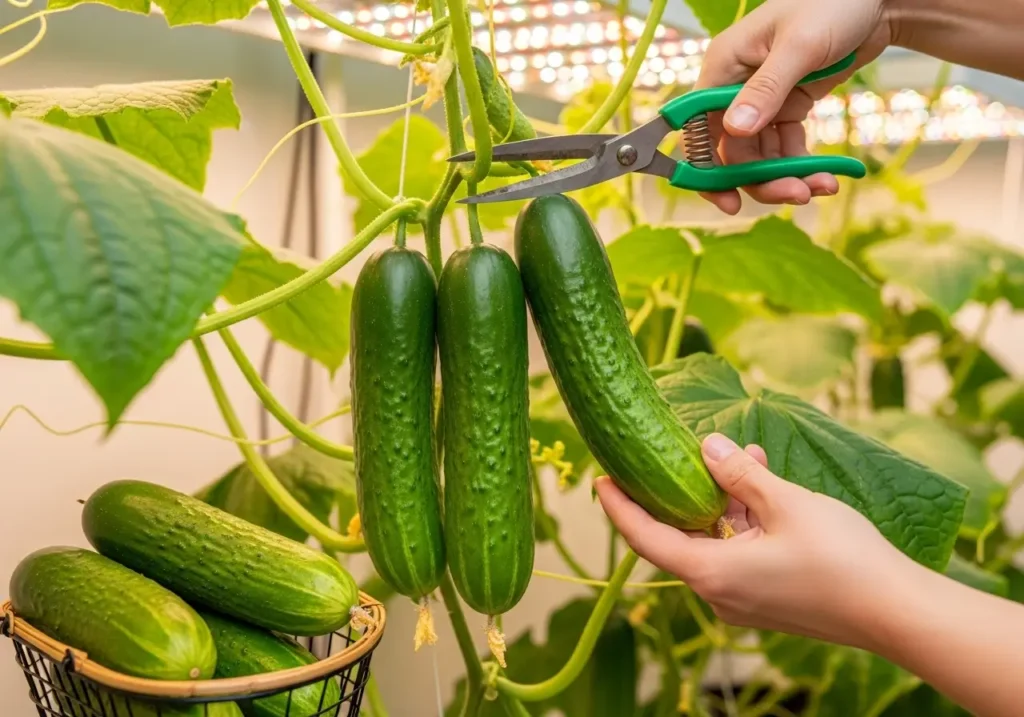
Want to know more about timing? Check out our guide on how long cucumbers take to grow for all the timing details.
Seasonal Considerations and Year-Round Growing
Indoor cucumber growing is absolutely amazing during winter when fresh produce costs a fortune and tastes like cardboard. I usually start my indoor plants in late fall and grow them through early spring, though you can totally do year-round if you want.
Summer can be challenging because of the heat and higher electricity bills from running lights and keeping things cool. I usually take a summer break from indoor cucumbers and focus on outdoor growing when the weather’s perfect.
Your Path to Indoor Cucumber Success Starts Now
Growing cucumbers indoors has totally changed my relationship with fresh produce. There’s something so satisfying about picking fresh cucumbers in January while everyone else dreams of spring. Plus, knowing exactly how they were grown and completely chemical-free? Priceless.
There’s a learning curve, and the initial setup costs can make you wince a little. But once you taste that first homegrown cucumber picked fresh from your indoor garden, you’ll understand why I’m so obsessed.
The secret is starting simple, learning as you go, and not being afraid to experiment. Every setup is different, and what works great for me might need some tweaking for your space and situation.
Ready to give this a shot? Start with just one plant, figure out the basics, and expand. I’d love to hear how it goes for you! What varieties worked best? What challenges did you run into? Any astonishing discoveries along the way? Please comment below, and let’s chat about this excellent indoor growing adventure!
Remember, the best time to start was last month, but the second-best time is right now. Your future self will thank you big time when you’re munching on fresh, crispy cucumbers while everyone else is counting down the days until spring!
Indoor Cucumber Growing Frequently Asked Questions
Can you really grow cucumbers indoors all year round?
Yes, you can successfully grow cucumbers indoors year-round with the right setup. You need adequate lighting (12-16 hours daily with LED grow lights), temperature control (70-75°F), proper containers (20+ gallons), and compact varieties like Bush Champion or Spacemaster that are suited for indoor growing.
How much does it cost to start growing cucumbers indoors?
Initial setup costs range from $200-500 depending on your choices. This includes containers ($25-65 each), LED grow lights ($80-500), support systems ($15-120), and growing supplies. While the upfront investment seems significant, you can save $200+ annually on fresh cucumbers.
Do I need to hand pollinate indoor cucumber plants?
Yes, hand pollination is essential for indoor cucumber growing since there are no natural pollinators indoors. Use a small paintbrush to transfer pollen from male flowers to female flowers each morning. Female flowers are easy to identify by the small cucumber-shaped swelling at their base.
What are the best cucumber varieties for growing indoors?
Bush varieties like ‘Bush Champion’ and ‘Spacemaster’ work best indoors because they stay compact while producing full-size cucumbers. Dwarf varieties like ‘Patio Pik’ are perfect for smaller spaces, and Asian varieties like ‘Suyo Long’ adapt well to indoor conditions with vertical growing systems.
